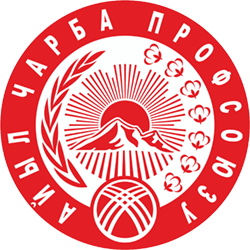
Chairman
Duishenov Niyazbek Eshmukhamedovich
Trade Union of Agro-Industrial Complex Workers and Municipal Employees in Agriculture of the Kyrgyz Republic

- In 1919, the County Trade Union of Land and Forestry Workers was founded.
- In 1934, at the 2nd Plenum of the Kyrgyz Soviet of Trade Unions, the following transformations took place:
- The trade union of workers of livestock state farms was divided into the trade union of workers of meat and dairy and vegetable-growing state farms and the trade union of workers of horse-breeding state farms.
- The trade union of workers of agricultural state farms and MTS (Machine and Tractor Stations) was split into the trade union of workers and employees of MTS in the East and the trade union of workers and employees of land management bodies.
- On February 1, 1941, the Republican Committee of the Trade Union of Workers and Employees of MTS and Land Management Bodies was established based on the two previous trade unions.
- On April 1, 1941, an Organizational Bureau was formed, uniting 194 trade union organizations with 16,278 members. On August 11, 1943, the 1st Republican Conference was held, where the Republican Committee was elected.
- On March 15, 1953, a decision was made to merge the trade unions into the Trade Union of Agricultural and Procurement Workers. On April 18, 1953, the first joint Plenum of the Central Committee of the trade union was held.
- On May 12, 1953, the Republican Committee of the Trade Union of Agricultural and Procurement Workers of the Kyrgyz SSR was established.
- During the period from 1934 to 1939, authorized representatives of the USSR Trade Union Central Committee were active, and after their abolition, their functions were transferred to the sectoral trade unions of the Kyrgyz SSR.
- After the liquidation of MTS in 1957, mechanizers and specialists began joining the trade union, and collective farmers joined en masse after the party congress in 1975.
- In 1981, the Trade Union of Agricultural and Procurement Workers was transformed into the Trade Union of Agricultural Workers.
- In 1985, with the establishment of the State Agro-Industrial Committee of the Kyrgyz SSR, the agricultural and food industry trade unions were merged into the Trade Union of Agro-Industrial Complex Workers. In 1992, food industry workers separated.
- In 2010, the Trade Union of Agro-Industrial Complex Workers was restructured into the Trade Union of Agro-Industrial Complex Workers and Municipal Employees in Agriculture of the Kyrgyz Republic.
The Agriculture Trade Union in Kyrgyzstan operates based on the Law of the Kyrgyz Republic “On Trade Unions” and other laws protecting workers’ rights, as well as in accordance with its Charter. Its structure includes the Central Committee, seven regional committees, more than 37 district committees, and over 1,200 primary organizations, bringing together 89,435 members.
The trade union focuses on regulating labor relations, ensuring occupational safety, promoting farmers’ products in domestic and foreign markets, improving employer-employee relations, strengthening the health of rural workers, and organizing summer recreation for their children.
Association of Trade Union Organizations “Trade Union of Agro-Industrial Complex Workers and Municipal Employees in Agriculture of the Kyrgyz Republic”
Trade Union of Food and Processing Industry Workers of the Kyrgyz Republic
By the time the Kara-Kyrgyz Autonomous Region was established in 1924, there were only 45 enterprises of various profiles operating in its territory, 28 of which belonged to the food industry.
1924 – The formation of public organizations began in the autonomous region.
January 12, 1925 – The first regional bureau for the creation of the trade union of food industry workers was established.
February 26, 1925 – The first Founding Congress of the Trade Union of the Food and Flavor Industry of the Kara-Kyrgyz Autonomous Region was held. It included 3 alcohol rectification plants, 4 state mills, a gut-processing plant, tobacco and mahorka production, sausage and confectionery workshops, bakeries, and canteens, with about 800 members.
January 1, 1926 – Membership in the trade union grew to 2,000.
During the 1920s and 1930s, the formation of the trade union and its organizational structure faced many challenges, including violations of trade union democracy. Leaders were appointed “from above,” turnover was high, and collective leadership was often reduced to mere administration.
Analysis of archival documents shows that during the years of socialist development, the trade union actively defended the socio-economic rights of workers and employees, organized socialist competitions, and contributed to production growth, improving working and living conditions, enhancing material well-being, meeting cultural needs, and promoting sports and physical activities.
In 1926, the Kara-Kyrgyz Autonomous Region was transformed into the Kyrgyz ASSR. As a result, on April 12, 1927, the 1st Republican Congress of the Trade Union of Food and Flavor Industry Workers was convened, officially establishing the trade union. At the time, the union included 1,500 employed members and 1,827 unemployed individuals.
Starting from 1930, the trade union underwent multiple structural changes, mergers, divisions, and renamings. Despite these changes, the number of food industry enterprises and, consequently, trade union membership continued to grow. Several key industrial facilities were commissioned, including the Frunze Meat Processing Plant, the Flour Milling Plant, the Tobacco Factory, 14 Dairy Plants, the Kant and Kara-Balta Sugar Factories, the Bakery Complex, and Winemaking Plants.
By 1937, enterprises in the food industry accounted for 50% of the total gross production. The second revival and formal reorganization of the Trade Union of Food Industry Workers occurred in 1949.
On July 15-16, 1949, the 1st Republican Conference of the sectoral trade union was held in Frunze, based on the union members from 25 enterprises and organizations, with a total of 2,500 workers. The conference resulted in the election of the Republican Committee and the Audit Commission of the Trade Union of Food Industry Workers. During the conference, a decision was made on the procedure for forming the union’s governing bodies, and the Charter was adopted.
By the end of 1949, workers from 36 more enterprises had joined the union. From 1951 to 1954, the trade union underwent another structural transformation.
In 1985, changes occurred in the economic structure of the USSR and the Kyrgyz SSR. Nine ministries and agencies were merged into a single agro-industrial complex. At the Founding Congress in 1986, the trade union of the sector decided to merge with the Trade Union of Agro-Industrial Complex Workers of the Republic.
The development of the trade union movement under the Soviet state demonstrated that, although the functions of trade unions changed depending on the priorities of the time, they always remained active participants in state and economic development and in addressing social issues.
Prioritizing the food and processing industry, the government of the republic adopted a resolution in 1992 to restore the sector and established the State Concern “Kyrgyz Tamak-Ash.” In connection with this decision, in March 1992, an organizing committee was formed to create and revive the Trade Union of Food and Processing Industry Workers of the Republic.
On April 24, 1992, at the 1st Founding Conference, the trade union was established. The Charter was adopted, and structural divisions were defined. Khalima Asankulovna Akeneeva was elected as the chairperson of the sectoral trade union. This date can thus be considered the day of the revival of one of the oldest trade unions.
In 1997, after the sudden passing of Akeneeva Kh.A., the sectoral trade union was headed by Sagynbek Apsalievich Apsaliev, a technical inspector of the sectoral trade union.
During the collapse of the USSR, the trade union faced severe challenges. The breakdown of economic ties, the loss of raw material sources, markets, and working capital led to the closure of some enterprises, while others struggled to survive.
New relationships had to be built with a different type of leadership—business managers whose primary goal was to maximize profits, including by reducing costs associated with human resources.
In the new conditions of economic and political reforms, after many years of working closely with party and government structures, trade unions gained independence from these bodies. Primary organizations acquired greater autonomy, and social dialogue and partnerships with various entities began to develop.
Delegates of the VI Conference of the Trade Union of Food and Processing Industry Workers of the Kyrgyz Republic outlined a number of priority tasks for the coming years:
- Protection of the social and labor interests and rights of wage workers;
- Increasing the effectiveness of the institution of social partnership by improving collective bargaining regulation of social and labor relations at all levels;
- Consolidation of trade union ranks and reform of their organizations;
- Organizational and financial strengthening of the trade union in line with modern requirements;
- Enhancing the effectiveness of trade union activities;
- Strengthening cooperation with the International Union of Food, Agricultural, Hotel, Restaurant, Catering, Tobacco, and Allied Workers’ Associations (IUF), of which the Trade Union of Food and Processing Industry Workers of Kyrgyzstan is a member organization;
- Educating wage workers and trade union leaders about their rights and how to exercise them.
Contact Information: (0312) 61-32-61, 0998 99-55-48
Bishkek, Chuy Ave. 207